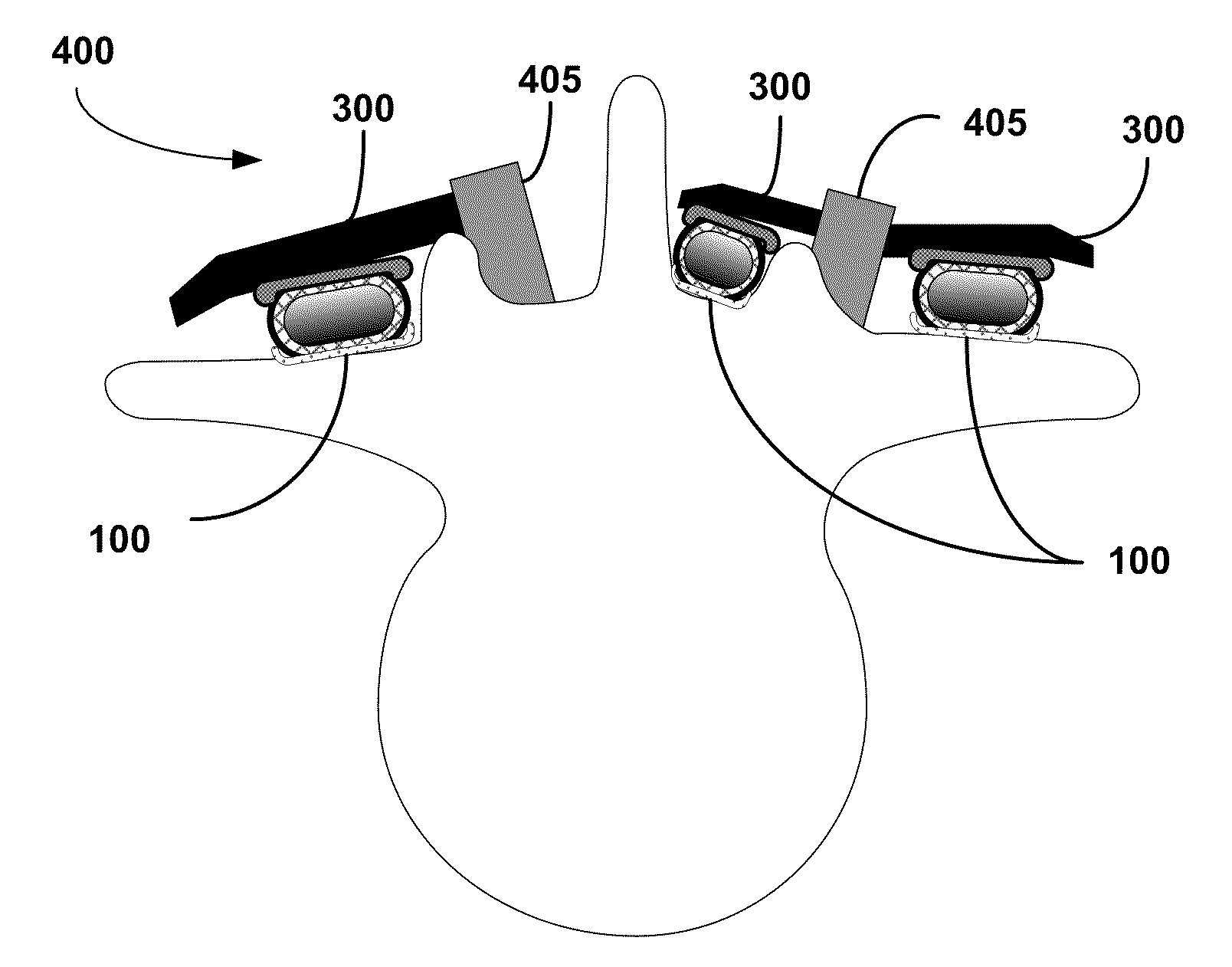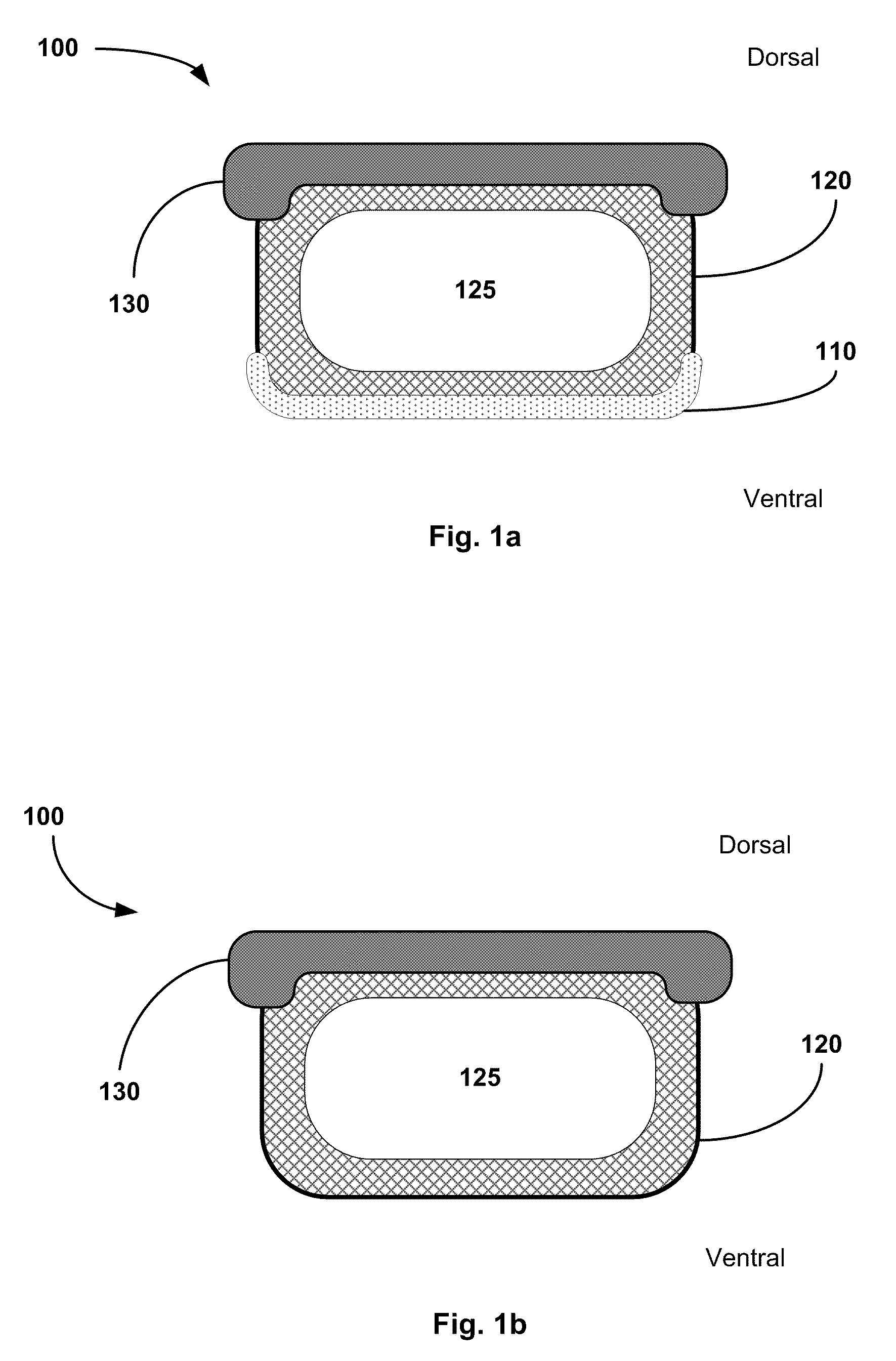[0009]Embodiments of the present invention are directed to a multi-layer osteogenic, osteoconductive, and osteoinductive carrier device or
system for applying an osteogenic, osteoconductive and / or osteoinductive biologic material to target sites in the
lumbar, thoracic and
cervical spine. This system will allow the application of these types of substances to a
bone surface, and methods for making and using said carrier or system. In an exemplary embodiment, the carrier can comprise three
layers: a first thin absorbent layer, which is adherent, easily moldable, and osteoinductive; a second adherent layer, which has a longer time of absorption than the first layer, and which is both osteoinductive and osteoconductive and even potentially osteogenic; and a third layer, which is more rigid but molded or pliable, absorbs over a substantially longer time than the first and second
layers, and is non-reactive.
[0012]The first layer can be adherent to bone and / or tissue. The
adhesive layer, also referred to as a first layer, can be adherent inherently or when activated by heat, fluid (such as sterile
saline, blood, or serum), or by another activating agent. The adherent properties of the first layer enable the carrier to stick to the surface of the decorticated bone at the planned fusion site once positioned there by the surgeon. The first layer is also preferably moldable / pliable, and rapidly absorbable by the body. This allows the first layer to substantially conform to the contours of the decorticated bone for an even distribution over the optimal contact area. The first layer can also be infused / impregnated with or able to stimulate
bone morphogenetic protein (BMP), an angiogenic factor, or another osteoinductive substance. Alternative, the first layer itself can be osteoconductive and / or osteoinductive.
[0015]The carrier and / or third layer can become activated when moistened, heated or otherwise altered making the
layers moldable / pliable. This allows the surgeon to further compress the carrier to substantially conform to the surface contours of the bone. The carrier, with the osteoinductive, osteogenic and / or osteoconductive substance within the second layer, can be applied directly onto the decorticated bone where fusion is desired. Once activated, the first layer can be adherent and can keep the carrier in the position determined by the surgeon as well as stimulating the communication of cells and stimulatory agents between the decorticated bone and the potential fusion
mass within the second layer. In an exemplary embodiment, the carrier can adopt a tubular shape. In another exemplary embodiment, the carrier is adapted for
insertion between adjacent vertebrae.
[0021]In other embodiments, the carrier can be adapted for use in fusion procedures in the
cervical spine. The carrier can be disc-shaped having an outer cylindrical wall defining a hollow inner chamber. The outer wall can be composed of a rigid, absorbable material capable of withstanding the axial loads in the cervical region. The outer wall can be composed of a material substantially similar to the third layer disposed above, although having substantially greater rigidity and
structural integrity with a potential for remaining structurally sound for up to 6-12 months. Conceivably, this type of construct could be absorbed from the top and bottom edges progressively so that it allows the vertebral bodies to progressively place
load sharing on the construct and thereby increasing the chance of obtaining a
solid fusion in contract to fixed rigid cages which minimize
load sharing and potentially shields the fusion material from forming
solid bone.
[0024]The osteoconductive properties of the embodiments of the carrier and its ability to also reliably deliver an osteoinductive substance to a fusion site increases the consistency of
bone formation and should increase the success rate for cervical surgeries. The embodiments of the carrier would also save a significant amount of time because it is largely self-contained, easily activated, and does not require a large amount of time on the part of the nurses and physician during the
surgery to construct and apply. This should save both time and money, and be
safer for the patient because it reduces operating room and
anesthesia time. The embodiments of the carrier could be used for both open fusions and
minimally invasive procedures.
 Login to View More
Login to View More  Login to View More
Login to View More 


